I’m pretty well known for making mistakes. It’s kind of a known trait of mine. Just this weekend I walked into a door because I didn’t open it properly first.
When it comes to social media, though, I try hard to learn from mistakes since they’re all saved for me to reflect on. Plus, I research and write about social media enough to have access to stats that make it easier to pick up and rectify these kind of mistakes.
The funny thing about some of the mistakes I looked at for this post is that the advice to avoid them is counterintuitive—sometimes even controversial. As we’ve seen before, though, counterintuitive advice is sometimes the best kind.
1. Losing out on traffic – Post the same thing multiple times
This is something that can be pretty controversial – a lot of people discourage re-posting links to the same content more than once. A good example of the controversy and why some tweeters continue to do it is Guy Kawasaki’s experience.
Guy is a big proponent of repeating your tweets, and has faced a lot of flack for it. After all, it doesn’t really make sense to send out the same thing multiple times… or does it?
Guy makes a good point that his followers probably aren’t reading his tweets at every moment of the day.
I repeat my tweets because I don’t assume that all my followers are reading me 24 x 7 x 365.
For Guy’s tweets that link to posts on his site, Holy Kaw, he repeats these four times, eight hours apart:
I picked eight hours because this means that even if the first tweet goes out at the worst times for traffic, one of the repeats will hit the best times… For example, a first tweet at 3:00 am Pacific then hits 11:00 am Pacific and 7:00 pm Pacific.
Guy also notes that he would lose out on traffic if he didn’t repeat his tweets, which is something we’ve examined before when looking at the best time to tweet:
I’ve examined the click-through patterns on repeat tweets, and each one gets about the same amount of traffic. If I tweeted stories only once, I would lose 75% of the traffic that I could get.
Here’s a typical example of the traffic from one of Guy’s tweets:
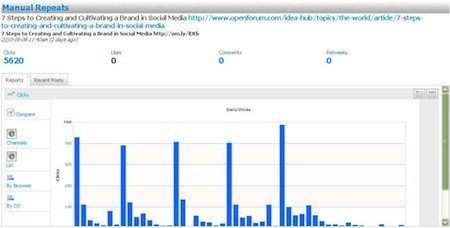
First post: 739 clicks
Second post: 718 clicks
Third post: 565 clicks
If I follow common wisdom, I would have tweeted it once and lost 1,200 clicks—that’s the bottom line.
This is something we do at Buffer as well. We use different headlines to test which one gets the best clicks for a particular post, and then we repeat the best one using Buffer to reach different timezones with the same content.
2. Using more tools than necessary – Don’t use all the tools available
As social media becomes a bigger part of our overall marketing strategies, more tools are becoming available to help us get the most out of our efforts. At first, it probably seems like a good idea to use as many tools as you can—after all, they all do different things.
In fact, this is probably a bad idea. It can divide your efforts so much that your whole strategy becomes diluted because you’re more focused on the tools you’re using that the results you’re aiming for.
Using just a couple of tools that actually improve your results and help you manage your strategy more effectively is a better option. Especially if we look at the latest social media statistics and the changes here, it becomes clear that less is more.
3. Measurement overwhelm – Don’t measure every social media metric you can
Social media marketing—like any marketing strategy—needs to prove its worth for us to keep spending money on it. We need to be able to point to solid results that show social media is working for us.
One of the biggest challenges in doing this is working out exactly what to measure. After all, there are so many different elements to measure, it can be hard to work out which ones are useful and which ones we’re looking at just because they’re easy to measure.
It’s important to realize why we’re looking at these metrics in the first place, so that we can choose the right metrics to focus on.
The only question we really need to answer is: Is social media worth it?
Working out what you should measure can take a few steps. Here are two to start with that can get you on the right path:
1. Define your goals
Once you know how social media marketing fits into your business’s overall objectives, you can work out what results you’re looking for. This gets you one step closer to choosing useful metrics to measure.
2. Choose a good metric
The difference between a ‘good’ and ‘bad’ metric really comes down to how useful it is to you. If you pick a metric that is hard to understand, or one that seems disconnected from the goals you’ve chosen, this can make it difficult to take action on the results you get. And if you’re not taking action, why are you measuring it in the first place?
This Marketing Land post offers some more advice on choosing metrics that are meaningful for your business, rather than measuring everything that’s available to you.
4. Publishing when no one’s online – Don’t publish your posts when you write them
I’ll finish writing around 1am and that’s a dumb time to Tweet because few people in the US are online. – Mark Suster
If anyone knows how much effort goes into creating a new piece of content, I’m one of them. I know how relieving it is to get something finished and finally share it with the world. Holding back when we’ve finished a great new post could actually be more useful for us, though.
The mistake with publishing as soon as we finish creating something new is that we’re not optimizing for our audience. Assuming that just because we’re online right now means our audience is online and open to consuming our content is an easy mistake to make.
A better approach would be to look at the best times for posting content online and work those into our strategies.
For instance, Facebook engagement is 18% higher on Thursdays and Fridays.
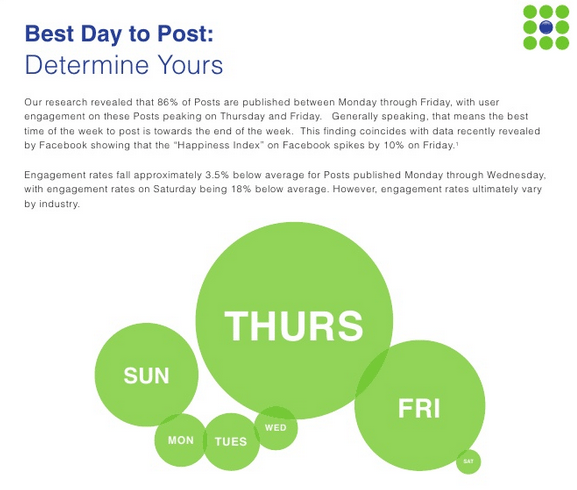
For Twitter, on the other hand, weekends are the best for high click-through rates.
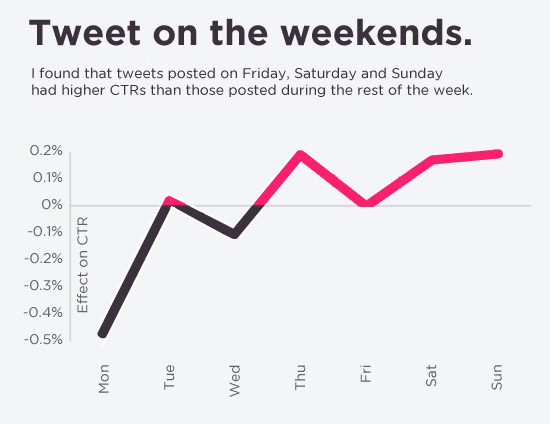
Take into account the best times for each network before you publish your content. And if you have a Buffer account, you can pre-set your schedules to reflect those times so you don’t have to think about it each time you publish something new.
5. Filling up the character count – Say less
Twitter’s 140-character limit is well-known. Being such a small message-length, and one of the defining features of the service, this one has garnered a lot more attention than Facebook or Google+’s character limits. It’s probably the one we focus on more, as well, since we’re not generally used to making a point in so few words.
Focusing on character-counts or word-limits can have a negative effect, though, when we start to squeeze in as much as we can fit. However, shorter posts actually get more engagement, on average.
On Twitter, tweets of less than 100 characters get 17% more engagement. For tweets with links, 120–130 characters is the best range.
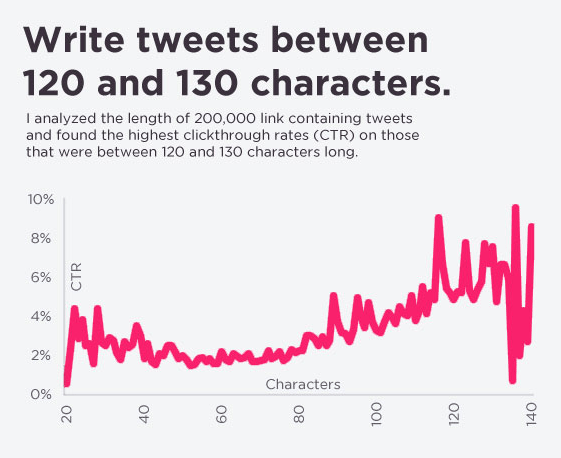
On Facebook we can see a similar trend:
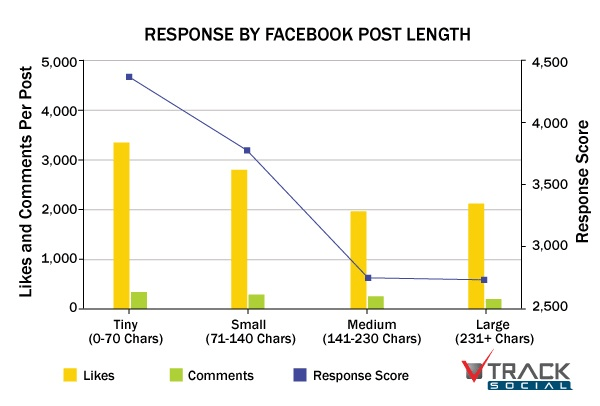
Keeping your posts below 250 characters can get you 60% more engagement than you might otherwise see. You can even get up to 66% more engagement if you cut it down to less than 80 characters. Regarding Facebook statistics we’ve found that the above changes especially were quite recent so it’s easy to keep to the old patterns.
6. More hashtags, less content – Get back to basics
Hashtags can be difficult to get right, since they can be both helpful or a hindrance to your engagement levels, depending on how you use them. Hashtags let you group your tweet with others around a particular topic or event, and help you to make it clear what you’re talking about very quickly.
Using Twitter hashtags correctly can mean 2x engagement for your tweets, but going overboard is an easy mistake to make. Just 1 or 2 hashtags can get you 21% more engagement than if you use 3 or more, so the trick is keeping your hashtags to a minimum.
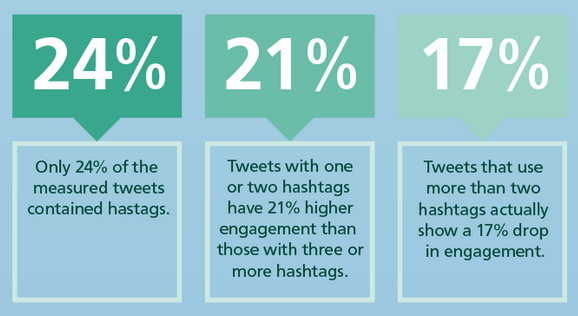
7. Talking to the wrong people – Don’t publish your posts when it’s convenient for you
From what we talked about in #4, you might be thinking that optimizing your social media marketing based on statistics will lead to more engagement and save you from “talking to no one.” Unfortunately, it’s not that easy. Knowing what the right headline for which audience is is something we’ve explored before, yet there are lots of factors to consider.
Since social media is still so new and hasn’t been studied much yet, it’s hard to find blanket statistics that hold true for all social media in all demographics, even as an average. Being aware of general statistics can be really helpful but it’s just as important (if not more so) to do your own testing to make sure your audience is online when you’re posting, rather than just anyone.
Here’s a good example:
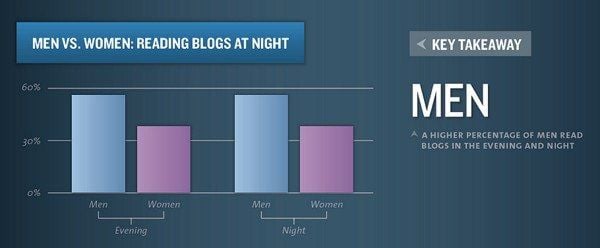
If more men read blogs at night than women, you’ll probably want to post earlier in the day if women are your target audience.
What other mistakes have you come across that we need to avoid? Let us know what you’ve noticed in the comments.
PS: For more insights on Social Media metrics and how to improve them, check out this post.
Try Buffer for free
190,000+ creators, small businesses, and marketers use Buffer to grow their audiences every month.


